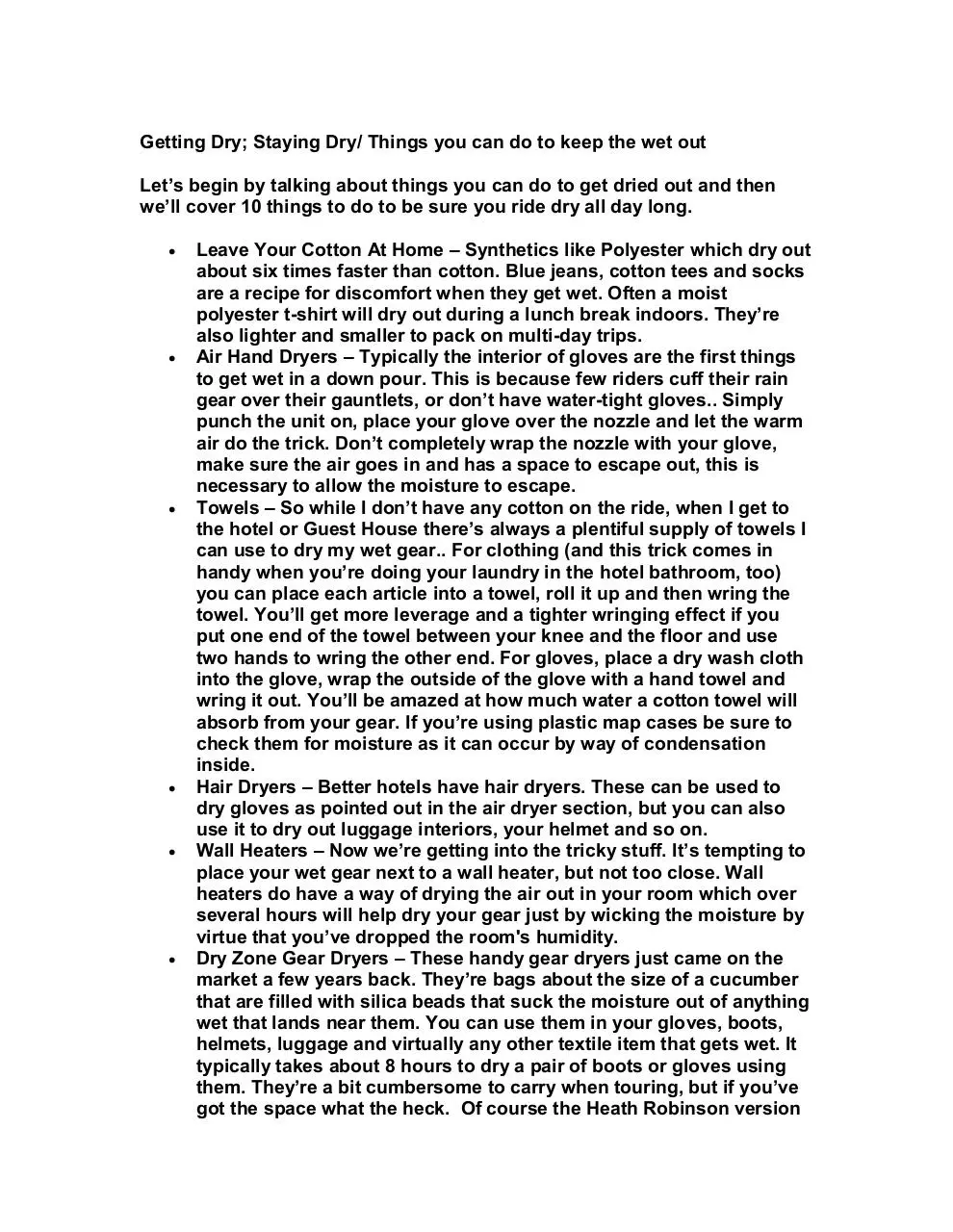Getting Dry (PDF)
File information
Title: Getting Dry; Staying Dry/ Things you can do to keep the wet out
Author: allsoppj
This PDF 1.3 document has been generated by Microsoft® Word 2010 / http://www.convertapi.com, and has been sent on pdf-archive.com on 12/02/2015 at 14:45, from IP address 77.96.x.x.
The current document download page has been viewed 691 times.
File size: 84.07 KB (2 pages).
Privacy: public file


File preview
Getting Dry; Staying Dry/ Things you can do to keep the wet out
Let’s begin by talking about things you can do to get dried out and then
we’ll cover 10 things to do to be sure you ride dry all day long.
Leave Your Cotton At Home – Synthetics like Polyester which dry out
about six times faster than cotton. Blue jeans, cotton tees and socks
are a recipe for discomfort when they get wet. Often a moist
polyester t-shirt will dry out during a lunch break indoors. They’re
also lighter and smaller to pack on multi-day trips.
Air Hand Dryers – Typically the interior of gloves are the first things
to get wet in a down pour. This is because few riders cuff their rain
gear over their gauntlets, or don’t have water-tight gloves.. Simply
punch the unit on, place your glove over the nozzle and let the warm
air do the trick. Don’t completely wrap the nozzle with your glove,
make sure the air goes in and has a space to escape out, this is
necessary to allow the moisture to escape.
Towels – So while I don’t have any cotton on the ride, when I get to
the hotel or Guest House there’s always a plentiful supply of towels I
can use to dry my wet gear.. For clothing (and this trick comes in
handy when you’re doing your laundry in the hotel bathroom, too)
you can place each article into a towel, roll it up and then wring the
towel. You’ll get more leverage and a tighter wringing effect if you
put one end of the towel between your knee and the floor and use
two hands to wring the other end. For gloves, place a dry wash cloth
into the glove, wrap the outside of the glove with a hand towel and
wring it out. You’ll be amazed at how much water a cotton towel will
absorb from your gear. If you’re using plastic map cases be sure to
check them for moisture as it can occur by way of condensation
inside.
Hair Dryers – Better hotels have hair dryers. These can be used to
dry gloves as pointed out in the air dryer section, but you can also
use it to dry out luggage interiors, your helmet and so on.
Wall Heaters – Now we’re getting into the tricky stuff. It’s tempting to
place your wet gear next to a wall heater, but not too close. Wall
heaters do have a way of drying the air out in your room which over
several hours will help dry your gear just by wicking the moisture by
virtue that you’ve dropped the room's humidity.
Dry Zone Gear Dryers – These handy gear dryers just came on the
market a few years back. They’re bags about the size of a cucumber
that are filled with silica beads that suck the moisture out of anything
wet that lands near them. You can use them in your gloves, boots,
helmets, luggage and virtually any other textile item that gets wet. It
typically takes about 8 hours to dry a pair of boots or gloves using
them. They’re a bit cumbersome to carry when touring, but if you’ve
got the space what the heck. Of course the Heath Robinson version
would be sealable food bags and the bags of silica gel that you get
with new shoes etc.
Dry Climate Air Drying – If you go through the desert and experience
a torrential down pour, you still might be in luck. Once the clouds
clear, even if it’s in the evening, the humidity will drop and you’ll
have good conditions for drying your gear. A combination of the
towel wringing trick and air drying in an arid climate works every
time.
Fire Pits – Ohhhh –. Begin by warming a few stones in the fire for an
hour or so. Then wrap your wet gear into tin foil, poke a few holes in
it, get the stones away from the flames and roast your wet gear on
the stones turning about every three to five minutes. For boots, wait
for the stones to cool a bit, wrap them in tin foil and place them into
your boots, moving them around just as often.
Sleep With Your Clothes –. Get your clothes as dry as possible and
then take them into bed with you. Most of your body heat is coming
from your core, so place them near your chest when you go to sleep
and move them around during the night whenever you wake up.
Download Getting Dry
Getting Dry.pdf (PDF, 84.07 KB)
Download PDF
Share this file on social networks
Link to this page
Permanent link
Use the permanent link to the download page to share your document on Facebook, Twitter, LinkedIn, or directly with a contact by e-Mail, Messenger, Whatsapp, Line..
Short link
Use the short link to share your document on Twitter or by text message (SMS)
HTML Code
Copy the following HTML code to share your document on a Website or Blog
QR Code to this page

This file has been shared publicly by a user of PDF Archive.
Document ID: 0000209108.